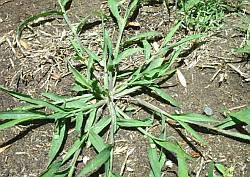Crabgrass Defined

For an annual weed, crabgrass certainly gets much attention. Crabgrass can turn what was a great looking lawn into a nightmare in the matter of just a few weeks. It grows from seed each year when the soil warms to about 55 or higher for at least a week in the spring but grows most rapidly during the heat of summer. The seed will usually germinate faster in bare soil areas or places near sidewalks or other places where the earth will warm up more quickly. A thick and healthy dense lawn is usually not where crabgrass will be most found because it does not compete well with taller plants or shade.
Crabgrass has coarser grass blades than typical lawn grasses and are also usually lighter green in color so the crabgrass plants are quite noticeable. Crabgrass usually has a low growing habit that spreads out along the ground. It will cover a somewhat circular area up to a foot wide but it can also grow up to 2 feet tall in some situations. As the stems arch over and grow along the ground, they will often produce roots at the nodes along the stems. It is very difficult to pull out a mature crabgrass plant because of all of those extra roots that the plant produces. After the stems elongate they begin flowering, usually starting about the beginning of August and continuing until a hard frost kills the plant. The flower heads looks like a hand with the fingers pointing upward. Seeds will ripen within a few weeks with each individual plant capable of producing 1,500 seeds.
Grassy Weed or Broadleaf
Control of crabgrass in Medina lawns is of primary concern for most homeowners that spend lots of money each year trying to prevent crabgrass from growing in their lawns. There are several active ingredients that are effective in crabgrass prevention, but one should check the label to be sure that products they are applying is in fact for crabgrass prevention and not for the control of broadleaf weeds. Those products will have no effect in controlling crabgrass. Commercial lawn care companies may also be able to apply the crabgrass prevention products alone, not in combination with a fertilizer but those products are usually not available to home owners.
Prevention
Crabgrass prevention products are usually quite effective if they are applied at the right time. People often refer to the time when lilacs or Forsythia are blooming as an indicator as to the proper time to apply the product to their turf. If you apply it too early or not enough, it may lose its effectiveness before the end of the summer, allowing for a late flush of crabgrass to emerge and grow. But, if you wait too long in the spring to apply it, you might miss the first wave of seedling germination and still have a major crabgrass problem. Once the seedlings are up and growing these products will not kill the seedlings. Crabgrass preventers will also prevent other kinds of weed seeds from germinating, like the grass seed that you might apply that spring or summer to fill in bare areas or to thicken and existing grass. If you plan to do some seeding, do it late in the fall to avoid problems with spring applied crabgrass preventers or simply choose not use them at all in those areas.
There are a very few post emergence crabgrass killing herbicides available. They can be effective but they need to be applied shortly after the crabgrass seedlings have emerged from the lawn. Once the plants begin to produce multiple stems control is greatly reduced which will make you unhappy because post emergent control is very expensive to apply. Another very important aspect of crabgrass control is to maintain a healthy lawn in Medina that is properly fertilized, watered and mowed.
Ready to find out more about Crabgrass?
Call Akron Canton Lawn Care Now for your Free Estimate on any of our lawn care services (330) 933-2222 or click the Contact Us button to send us an email.